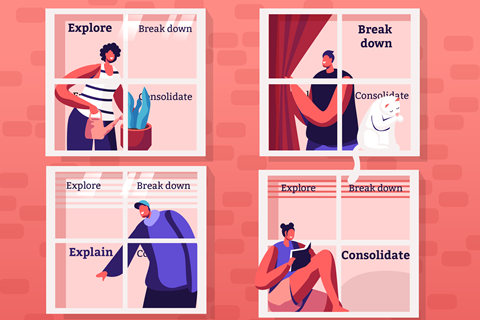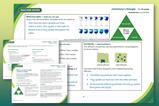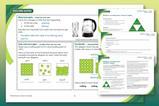Explore, break down, explain and consolidate chemistry concepts

Teachers have long used Frayer models to support students with vocabulary acquisition and understanding, where exploring the definition, characteristics, examples and non-examples of a word can help students delve into the deeper meaning of the word or phrase.
Used in this sense, teachers often provide the definition box with three other boxes for further exploration of the word’s meaning and relationship to the students’ prior exposures. As literacy levels are important in students’ access to science, this is certainly a useful focus for your use of Frayer models.
However, Frayer models have a much broader scope when you tune the focus to the desired outcome – for instance, organising students’ ideas around a concept. Here, structuring the four sections as explore, break down, explain and consolidate allows us to access, and assess, a student’s understanding at various points. The framework not only provides an insight into the conceptions a student may hold but also offers a window into their science capital.
More resources to support literacy in the science classroom
Discover our latest literacy support resources by key topic. Each set includes:
- key term support pack, with Frayer models, definitions, accessible glossary and unscrambling definitions
- structured talk activity
- reading comprehension
- structure strips to support independent writing.
Find them along with our carefully curated collection of articles and classroom-ready activities to help you embed literacy into your existing lessons.
Teachers have long used Frayer models to support students with vocabulary acquisition and understanding, where exploring the definition, characteristics, examples and non-examples of a word can help students delve into the deeper meaning of the word or phrase (rsc.li/3E61FRN).
Used in this sense, teachers often provide the definition box with three other boxes for further exploration of the word’s meaning and relationship to the students’ prior exposures. As literacy levels are important in students’ access to science, this is certainly a useful focus for your use of Frayer models.
However, Frayer models have a much broader scope when you tune the focus to the desired outcome – for instance, organising students’ ideas around a concept (rsc.li/4te0YGA). Here, structuring the four sections as explore, break down, explain and consolidate allows us to access, and assess, a student’s understanding at various points. The framework not only provides an insight into the conceptions a student may hold but also offers a window into their science capital.
The four sections
- Explore: get students thinking about their prior knowledge and experiences. What do they already know about the topic, phrase or word? Have they come across it in books or on TV? For example, if they’re looking at elements, do they just say, ‘they’re on the periodic table,’ or do they mention favourite elements, their properties or where they’ve seen them used? They can draw or write their responses. If they’re stuck, show an image to prompt them. This is a great opportunity for sharing ideas, valuing the different experiences each student brings to the topic. Ask learners to work in pairs or threes to each read out their responses. This allows them to compare similarities and differences between them.
- Break down: dig into the details. Where does the word come from? What other words can they link to it? This stage again draws on the students’ science capital, helping them build connections between what they know and what they’re learning.
- Explain: now it’s their turn to put it all together. Can learners describe the concept in their own words? Encourage them to be clear and precise.
- Consolidate: time to apply their knowledge. I give my learners a selection of diagrams, then ask them which ones represent elements, for example, why some work and why some don’t. This step makes learning hands-on and personal, drawing on each student’s science capital.

You can also use the Frayer model to support your students to interact with unknown objects, be these images or physical items. Framing the four quadrants as a tool for exploring the unknown can foster scientific curiosity, questioning skills and inference making, thereby contributing to the development of science capital. For example, you could give students a video of bubbles floating part way up a container or a wave of carbon dioxide gas extinguishing candles. You might encourage them to describe their observations, determine which aspects are specific to this situation and identify defining characteristics. They can then generate questions and make inferences based on the evidence they collect. For students less familiar with this style of inquiry, scaffolding questions – such as What did you see in the video? Was this what you expected? Why/why not? and What does this make you want to ask? – can guide them. While students can answer these questions individually, they often, in my classroom at least, work best as part of a discussion, allowing students to share and refine ideas collaboratively.
Empowering students to ask questions and derive answers from information they have collected is vital if we are to enable them to think scientifically about the world. Encouraging this approach helps students design scientific solutions to the many and varied challenges they will encounter, promoting a deeper engagement with chemistry.
More resources
- Find Frayer models in 10 practical videos and supporting resources for 14–16 year-olds, covering experiments such as paper chromatography, electrolysis of aqueous solutions and rates of reaction.
- Overcome four chemistry language challenges for EAL learners with researched-informed teaching tips.
- Build your learners’ confidence with science language and try these simple strategies to ensure students grasp new tier 3 terms.
- Embed these ideas and methods to improve students’ literacy skills through explicit scientific writing.
- Watch science communicator, Fernando’s video job profile with your class to show how he uses his communication and comprehension skills.
Jo Haywood
Discover our latest literacy support resources, including Frayer models, by key topic on the RSC Education website: rsc.li/4kmWaxu














No comments yet